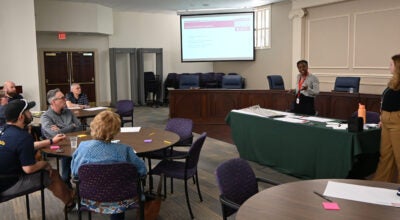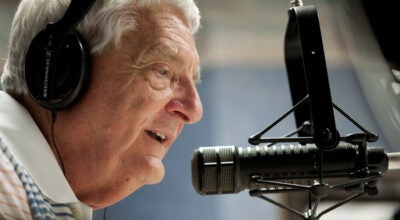Robertson Foundation takes big step toward creating a ‘Central Park’ for Salisbury
Published 12:00 am Sunday, July 31, 2016
By Mark Wineka
mark.wineka@salisburypost.com
SALISBURY — The Blanche & Julian Robertson Family Foundation is purchasing an entire city block in downtown Salisbury in hopes of transforming it into an urban park with the Bell Tower as one of the most identifiable anchors.
“It will be our Central Park,” said Margaret Kluttz, chairperson of the Robertson Foundation board.
On Thursday, the Robertson Foundation exercised an option it has held for the past year, agreeing to pay the Maxwell Chambers Trust $1.75 million for the block of property bounded by West Innes, South Church, West Fisher and South Jackson streets.
Only the old Session House, under which Chambers was buried long ago, remains with the trust, which is tied to First Presbyterian Church.
Otherwise, the Bell Tower, Gazebo Park, the former Wrenn House restaurant, the former First Bank building and all the surface parking connected with those properties will come under the control of the Robertson Foundation.
Neighbors on the immediate fringes to this site include Rowan Public Library, First Presbyterian Church, First Methodist Church and St. John’s Lutheran Church.
“It is truly exciting,” Kluttz said. “We don’t have these opportunities very often.”
Kluttz said the development of an urban park should provide valuable segues to churches, neighborhoods and downtown businesses and offices. “We have a unique opportunity,” she said.
Kluttz envisions it being the kind of park to which out-of-town visitors will be attracted, but she stressed, “This is for our citizens, our community and Rowan County.”
Kluttz anticipates that her board will soon be hiring a landscape architect for development of an overall plan.
“We’ll have more to tell in three to six months, I’m sure,” she added. “… It’s all built on good faith at this point.”
Once the foundation board decided to exercise its option and proceed with an urban park concept, Fred and Alice Stanback stepped up with a monetary pledge offered as a challenge to the rest of the community.
Kluttz said several other families have already responded. “We have a lot of fundraising to do to have it totally paid off,” Kluttz said, adding a “significant amount” has been raised and a “significant amount” will still have to be collected for the project.
Kluttz wasn’t sure what the future holds for the former bank building, which dominates a portion of the site. But she does see the Bell Tower, Gazebo Park and Wrenn House — and even Rowan Museum’s Utzman-Chambers House across South Jackson Street — as being key complements of any urban park design.
What becomes of the surface parking that now serves the library, Salisbury Post and at times the neighboring churches also represents one of the challenges, Kluttz said.
Kluttz, a former mayor of Salisbury, said the project might be able to look at the Elizabeth Holmes Hurley Park near Novant Health Rowan Medical Center as a guide for helping the urban park become established and keep evolving.
Another question down the road could be who takes over the park’s supervision and maintenance. Will it become part of the city park system? At this point, Kluttz isn’t sure.
When the Robertson Foundation board first took out an option on the Maxwell Chambers Trust property last summer, it saw itself as a facilitator for a redevelopment of the property.
Kluttz said at the time the foundation was “not in the development business.”
The option gave the foundation 12 months to work on laying out some of possibilities for the city block and finding the parties to follow through on them.
Maxwell Chambers set up the trust in the 19th century so these properties could generate income for First Presbyterian Church. They did provide revenue for more than 150 years.
But the closing of the restaurant and the bank cut the flow of income, In 2014, the Maxwell Chambers Trust — the elders of First Presbyterian Church serve as its board — successfully had the terms of the trust modified in court so it would be allowed to sell or mortgage parts of the property, not including the Session House.
Chambers, who died in 1855, exerted great influence from the grave for some 160 years. The trust he set up previously had prohibited the church elders from selling the real estate owned by the trust.
Because Chambers and members of his family are buried under the Session House, First Presbyterian Church — for as long as it exists — is obligated to maintain the property. That did not change with the court’s modification to other terms of the trust in 2014.
The court modification was allowed because it was seen as bringing the trust up to date with current lending laws. The ruling allowed the board to sell most of the property in that block or borrow against its value to make renovations that would attract new tenants.
Kluttz said the trust had exhaustively tried to bring income-producing enterprises to that block without success.
In memory of his late parents and to honor them and his hometown, Wall Street money manager Julian H. Robertson Jr. created the family foundation in 1997. Since then, the foundation has donated millions of dollars toward schools, programs and causes that “employ inovation, thoroughness and commitment when giving back.”
Its website adds, “Improving life in Salisbury has been at the core of the foundation’s mission’s since the beginning.”
Contact Mark Wineka at 704-797-4263.




